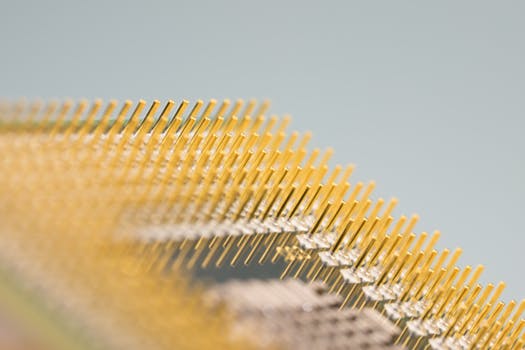TheDeveloperBlog.com
C-Sharp | Java | Python | Swift | GO | WPF | Ruby | Scala | F# | JavaScript | SQL | PHP | Angular | HTML
Java 2D Array Examples
Use 2D arrays and jagged arrays. Initialize arrays and assign elements.Step 1: We introduce a two-dimensional array of width 4 and height 4—a little square.
Step 2: We assign some elements with the array at indexes (two are required, an X and a Y).
Step 3: Here we loop over the top-level elements in a for-loop—each element itself contains another array.
Step 4: We use the subarrays like a one-dimensional array containing int values. We have an array of equal-length arrays.
Java program that uses 2D array
public class Program {
public static void main(String[] args) {
// Step 1: create 2-dimensional array.
int[][] values = new int[4][4];
// Step 2: assign three elements in it.
values[0][0] = 1;
values[1][1] = 2;
values[3][2] = 3;
// Step 3: loop over top-level arrays.
for (int i = 0; i < values.length; i++) {
// Step 4: loop and display sub-arrays.
int[] sub = values[i];
for (int x = 0; x < sub.length; x++) {
System.out.print(sub[x] + " ");
}
System.out.println();
}
}
}
Output
1 0 0 0
0 2 0 0
0 0 0 0
0 0 3 0
Note: This syntax requires just one line. It is easier to type and review for humans.
Java program that uses 2D array initializer
public class Program {
public static void main(String[] args) {
// Use initialize syntax.
int[][] values = { { 1, 2 }, { 3, 4 } };
System.out.println(values[0][0]);
System.out.println(values[1][0]);
System.out.println(values[0][1]);
System.out.println(values[1][1]);
}
}
Output
1
3
2
4
And: The first subarray has two elements. The second one has three String elements. We loop over all these values.
StringsJava program that uses jagged array
public class Program {
public static void main(String[] args) {
// Create an array of String arrays: a jagged array.
String[][] values = new String[2][];
// Fill first row with 2-element array.
values[0] = new String[2];
values[0][0] = "cat";
values[0][1] = "dog";
// Use 3-element array for second row.
values[1] = new String[3];
values[1][0] = "fish";
values[1][1] = "bird";
values[1][2] = "lizard";
// Display rows and elements.
for (String[] array : values) {
for (String element : array) {
System.out.print(element);
System.out.print(" ");
}
System.out.println();
}
}
}
Output
cat dog
fish bird lizard
Tip: Three-dimensional arrays can often be replaced with lesser-dimensioned arrays. This would likely be faster.
Java program that creates 3D array
public class Program {
public static void main(String[] args) {
// Create space cube with 9 points.
byte[][][] space = new byte[3][3][3];
space[0][0][0] = 10;
space[1][1][1] = 20; // Middle of the cube.
space[2][2][2] = 30;
// Display points in our space-cube.
System.out.println(space[0][0][0]);
System.out.println(space[1][1][1]);
System.out.println(space[2][2][2]);
}
}
Output
10
20
30
Here: I develop a flattened 2D array, which uses a multiply and add to locate elements in a 1D array.
Indexes: We add the X coordinate to the Y coordinate multiplied by the number of rows. Two indexes are combined into one.
Java program that uses flattened 2D array
public class Program {
public static void main(String[] args) {
// Create 4 by 4 one-dimension array.
// Can access 0, 0 through 3, 3 with multiplication.
int[] array = new int[4 * 4];
// Assign locations in the flattened array.
array[0 + (1 * 4)] = 10; // 0, 1
array[3 + (3 * 4)] = 100; // 3, 3
array[2 + (2 * 4)] = 1000; // 2, 2
// Read those locations.
System.out.println(array[0 + (1 * 4)]);
System.out.println(array[3 + (3 * 4)]);
System.out.println(array[2 + (2 * 4)]);
// Read an empty location.
System.out.println(array[3 + (2 * 4)]); // 3, 2
}
}
Output
10
100
1000
0
Version 1: Here we benchmark a flattened array (a 2D array stored as a 1D array).
Version 2: In this version of the code we use a real 2D array, and use 2 indexes to get an element.
Result: The program shows the performance advantage of 1D arrays over 2D arrays. A flat array is nearly twice as fast.
Java program that benchmarks flat, 2D arrays
public class Program {
public static void main(String[] args) {
int[] flat = new int[10 * 10]; // Flattened 10 x 10 array.
flat[0 + (4 * 10)] = 1;
int[][] two = new int[10][10]; // 10 x 10 two-dimensional array.
two[0][4] = 1;
long t1 = System.currentTimeMillis();
// Version 1: read, assign flattened array.
for (int i = 0; i < 100000000; i++) {
int value = flat[0 + (4 * 10)];
flat[9 + (9 * 10)] = value;
}
long t2 = System.currentTimeMillis();
// Version 2: read, assign 2D array.
for (int i = 0; i < 100000000; i++) {
int value = two[0][4];
two[9][9] = value;
}
long t3 = System.currentTimeMillis();
// ... Times.
System.out.println(t2 - t1);
System.out.println(t3 - t2);
}
}
Output
131 ms, Flattened 1D array, load and store
256 ms, 2D array, load and store
Related Links:
- Java Continue Keyword
- Java Convert Char Array to String
- Java Combine Arrays
- Java Console Examples
- Java Web Services Tutorial
- Java Odd and Even Numbers: Modulo Division
- Java IO
- Java 9 Features
- Java 8 Features
- Java String
- Java Regex | Regular Expression
- Java Filename With Date Example (Format String)
- Java Applet Tutorial
- Java Files.Copy: Copy File
- Java filter Example: findFirst, IntStream
- Java Final and final static Constants
- Java Super: Parent Class
- Java Date and Time
- Java do while loop
- Java Break
- Java Continue
- Java Comments
- Java Splitter Examples: split, splitToList
- Java Math.sqrt Method: java.lang.Math.sqrt
- Java Reflection
- Java Convert String to int
- JDBC Tutorial | What is Java Database Connectivity(JDBC)
- Java main() method
- Java HashMap Examples
- Java HashSet Examples
- Java Arrays.binarySearch
- Java Integer.bitCount and toBinaryString
- Java Overload Method Example
- Java First Words in String
- Java Convert ArrayList to String
- Java Convert boolean to int (Ternary Method)
- Java regionMatches Example and Performance
- Java ArrayDeque Examples
- Java ArrayList add and addAll (Insert Elements)
- Java ArrayList Clear
- Java ArrayList int, Integer Example
- Java ArrayList Examples
- Java Boolean Examples
- Java break Statement
- Java Newline Examples: System.lineSeparator
- Java Stream: Arrays.stream and ArrayList stream
- Java charAt Examples (String For Loop)
- Java Programs | Java Programming Examples
- Java OOPs Concepts
- Java Naming Conventions
- Java Constructor
- Java Class Example
- Java indexOf Examples
- Java Collections.addAll: Add Array to ArrayList
- Java Compound Interest
- Java Int Array
- Java Interface Examples
- Java 2D Array Examples
- Java Remove HTML Tags
- Java Stack Examples: java.util.Stack
- Java Enum Examples
- Java EnumMap Examples
- Java StackOverflowError
- Java startsWith and endsWith Methods
- Java Initialize ArrayList
- Java Object Array Examples: For, Cast and getClass
- Java Objects, Objects.requireNonNull Example
- Java Optional Examples
- Java Static Initializer
- Java static Keyword
- Java Package: Import Keyword Example
- Java Do While Loop Examples
- Java Double Numbers: Double.BYTES and Double.SIZE
- Java Truncate Number: Cast Double to Int
- Java Padding: Pad Left and Right of Strings
- Java Anagram Example: HashMap and ArrayList
- Java Math.abs: Absolute Value
- Java Extends: Class Inheritance
- Java String Class
- Java String Switch Example: Switch Versus HashMap
- Java StringBuffer: append, Performance
- Java Array Examples
- Java Remove Duplicates From ArrayList
- Java if, else if, else Statements
- Java Math.ceil Method
- Java This Keyword
- Java PriorityQueue Example (add, peek and poll)
- Java Process.start EXE: ProcessBuilder Examples
- Java Palindrome Method
- Java parseInt: Convert String to Int
- Java toCharArray: Convert String to Array
- Java Caesar Cipher
- Java Array Length: Get Size of Array
- Java String Array Examples
- Java String compareTo, compareToIgnoreCase
- Java String Concat: Append and Combine Strings
- Java Cast and Convert Types
- Java Math.floor Method, floorDiv and floorMod
- Java Math Class: java.lang.Math
- Java While Loop Examples
- Java Reverse String
- Java Download Web Pages: URL and openStream
- Java Math.pow Method
- Java Math.round Method
- Java Right String Part
- Java MongoDB Example
- Java Substring Examples, subSequence
- Java Prime Number Method
- Java Sum Methods: IntStream and reduce
- Java switch Examples
- Java Convert HashMap to ArrayList
- Java Remove Duplicate Chars
- Java Constructor: Overloaded, Default, This Constructors
- Java String isEmpty Method (Null, Empty Strings)
- Java Regex Examples (Pattern.matches)
- Java ROT13 Method
- Java Random Number Examples
- Java Recursion Example: Count Change
- Java reflect: getDeclaredMethod, invoke
- Java Count Letter Frequencies
- Java ImmutableList Examples
- Java String equals, equalsIgnoreCase and contentEquals
- Java valueOf and copyValueOf String Examples
- Java Vector Examples
- Java Word Count Methods: Split and For Loop
- Java Tutorial | Learn Java Programming
- Java toLowerCase, toUpperCase Examples
- Java Ternary Operator
- Java Tree: HashMap and Strings Example
- Java TreeMap Examples
- Java while loop
- Java Convert String to Byte Array
- Java Join Strings: String.join Method
- Java Modulo Operator Examples
- Java Integer.MAX VALUE, MIN and SIZE
- Java Lambda Expressions
- Java lastIndexOf Examples
- Java Multiple Return Values
- Java String.format Examples: Numbers and Strings
- Java Joiner Examples: join
- Java Keywords
- Java Replace Strings: replaceFirst and replaceAll
- Java return Examples
- Java Multithreading Interview Questions (2021)
- Java Collections Interview Questions (2021)
- Java Shuffle Arrays (Fisher Yates)
- Top 30 Java Design Patterns Interview Questions (2021)
- Java ListMultimap Examples
- Java String Occurrence Method: While Loop Method
- Java StringBuilder capacity
- Java Math.max and Math.min
- Java Factory Design Pattern
- Java StringBuilder Examples
- Java Mail Tutorial
- Java Swing Tutorial
- Java AWT Tutorial
- Java Fibonacci Sequence Examples
- Java StringTokenizer Example
- Java Method Examples: Instance and Static
- Java String Between, Before, After
- Java BitSet Examples
- Java System.gc, Runtime.getRuntime and freeMemory
- Java Character Examples
- Java Char Lookup Table
- Java BufferedWriter Examples: Write Strings to Text File
- Java Abstract Class
- Java Hashtable
- Java Math class with Methods
- Java Whitespace Methods
- Java Data Types
- Java Trim String Examples (Trim Start, End)
- Java Exceptions: try, catch and finally
- Java vs C#
- Java Float Numbers
- Java Truncate String
- Java Variables
- Java For Loop Examples
- Java Uppercase First Letter
- Java Inner Class
- Java Networking
- Java Keywords
- Java If else
- Java Switch
- Loops in Java | Java For Loop
- Java File: BufferedReader and FileReader
- Java Random Lowercase Letter
- Java Calendar Examples: Date and DateFormat
- Java Case Keyword
- Java Char Array
- Java ASCII Table
- Java IntStream.Range Example (Get Range of Numbers)
- Java length Example: Get Character Count
- Java Line Count for File
- Java Sort Examples: Arrays.sort, Comparable
- Java LinkedHashMap Example
- Java Split Examples